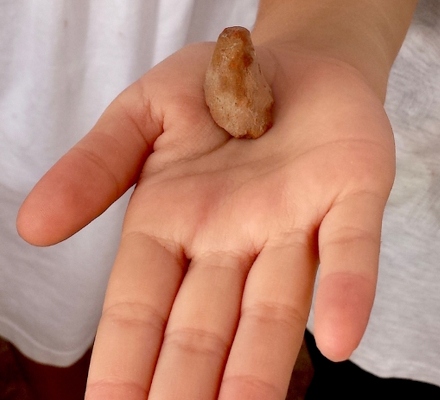Find of the Month: Figurine Fragment – Or & Naya Korshaya
This October, sisters Or and Naya Korshaya found the leg of a figurine, most likely of a horse. Though they are from Jerusalem, it was their first time at the Sifting Project. Finding something so special was a great way to spend the day and it sparked an interest in archaeology!
- Or and Naya Korshaya
- animal leg found by the Korshaya sisters
Most of the figurines found by the Sifting Project are from the Iron II period (8th-6th centuries BCE) and may be related to cultic activities. Our expert, Aaron Greener, is researching these figurines, which provide an important addition to the thousands of similar figurines found in Judahite sites from that time period.
The Sifting Project does not have any completely intact figurines, but rather small broken pieces, most broken in antiquity. We have a number of female pillar figurines and a variety of four legged animals. Most of these are horses and some of them have riders. It would be interesting to know if the leg found by the Korshaya sisters was from a horse with a rider, but because we only have the bottom of the leg, we can’t see the leg of a rider if there were one.

Other fragments of figurines found by the Sifting Project
Because of their fragmented condition, some scholars have related the broken figurines of the Iron Age Judahite sites to the biblical account of Hezekiah’s or Josiah’s religious reforms. According to the Bible, symbols of idol worship were systematically destroyed and abolished.
Aaron will be presenting his research at the Annual Ingeborg Rennert Center for Jerusalem Studies Conference in January and will be published in the first volume of our planned publication.
Thank you so much to the Korshaya family for volunteering with us and finding something so valuable to Israeli archaeology and our understanding of the Temple Mount.
Discover more from The Temple Mount Sifting Project
Subscribe to get the latest posts sent to your email.














Reblogged this on Kattukse Vrienden voor Israël.
you know, not EVERYTHING is cultic, or something mystical. sometimes a cigar is just a cigar, and a horse’s leg could be a toy
Due to the time period, and the fact that it was found on the Temple Mount, as well as the assemblages of similar artifacts found at other sites within the area that was then Judea, the likelihood that this is in fact a cultic object is very high. Of course not everything is a cultic object. We have many cooking pots from the first and second temple period for example that we have not confused with vessels for libation or other sacrificial activities. In this case though, our expert has used a lot of corroborating evidence to make this claim. Thanks for the comment though! It is always good to be skeptical and look deeper into matters, especially when it is written in a short blog post that doesn’t give so many details. I will be happy to connect you with our expert or forward you his article in English when it is published. Let me know and have a great day!
Here are links to Aaron’s conference paper on Temple Mount figurines.
English Abstract:
https://www.academia.edu/31116738/Iron_Age_II_Figurine_Fragments_from_the_Temple_Mount_Soil._In_Baruch_E._and_Faust_A._eds_New_Studies_on_Jerusalem_Vol._22._Ramat-Gan_2017_English_abstract_
Hebrew Full Report:
https://www.academia.edu/31116717/Iron_Age_II_Figurine_Fragments_from_the_Temple_Mount_Soil._In_Baruch_E._and_Faust_A._eds_New_Studies_on_Jerusalem_Vol._22._Ramat-Gan_2017_pp._123-146_Hebrew_